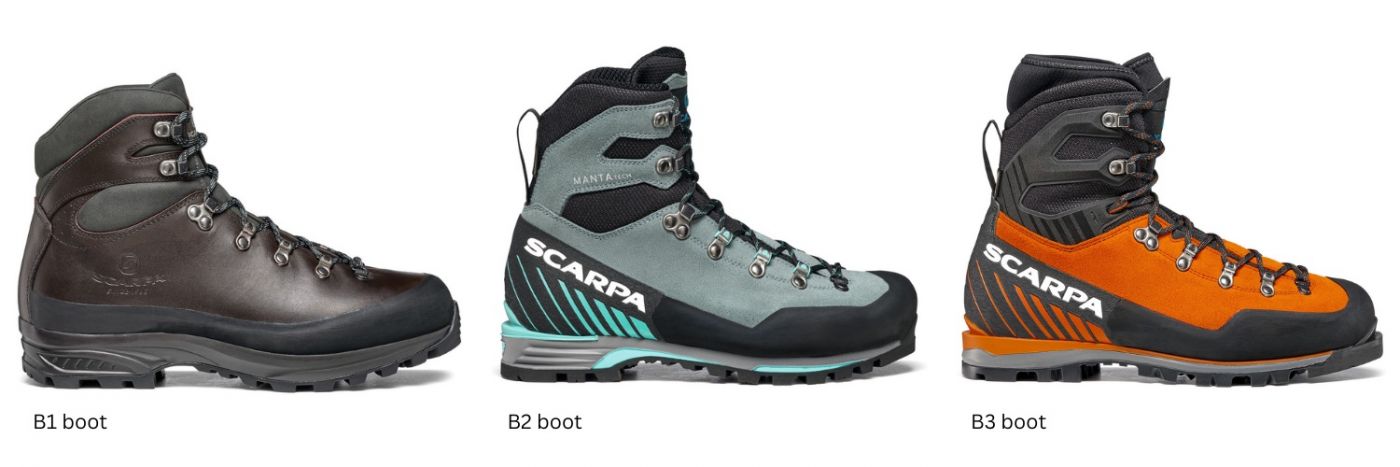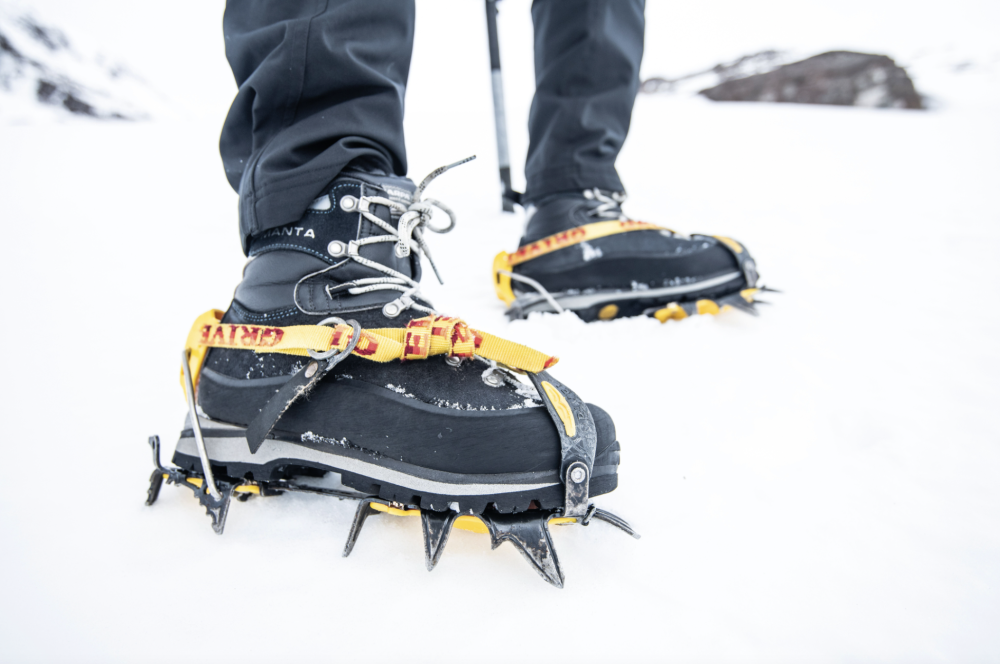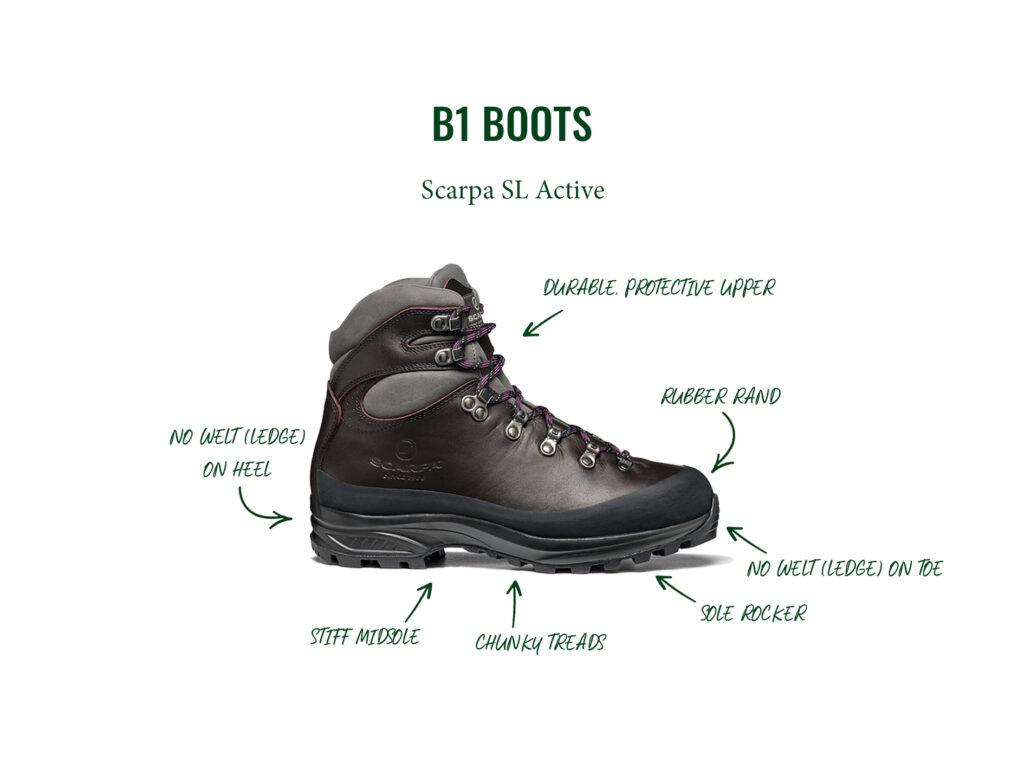The Complete Guide to B1 Hiking Boots: Your Gateway to Four-Season Mountain Adventures
After spending over a decade testing B1 hiking boots across four seasons in diverse mountain conditions, I've learned that these versatile boots represent the sweet spot between comfort and technical performance. Whether you're planning summer scrambles in the Scottish Highlands or winter ascents with crampons, choosing the right B1 boots can transform your mountain experience. Discover expert insights, tested recommendations, and practical guidance for your next adventure. Explore National Parks Store offers the complete selection you need.
Understanding B1 Hiking Boots: The Perfect Balance for Year-Round Adventures

B1 hiking boots occupy a unique position in the mountaineering boot hierarchy, serving as the bridge between flexible hiking footwear and rigid technical mountaineering boots. After extensively testing various B1 models across different terrains and seasons, I can confidently say they represent the optimal compromise for adventurous hikers who want versatility without sacrificing performance.
The "B1" designation refers to the European boot stiffness rating system, where these boots feature semi-rigid construction with enough stiffness to accommodate C1 strap-on crampons while maintaining sufficient flexibility for comfortable all-day hiking. Unlike their softer B0 cousins or stiffer B2 and B3 counterparts, B1 boots excel in that middle ground where hiking boot comfort meets technical capability.
What sets B1 boots apart is their robust construction featuring protective rubber rands, waterproof membranes typically using Gore-Tex technology, and reinforced toe and heel areas. During my testing in Colorado's challenging terrain, I've found that the rigid midsole provides excellent support on rocky scrambles while the protective rand shields against scree damage. The crampon compatibility opens up winter opportunities that would be impossible with traditional hiking boots, making them invaluable for Colorado hiking adventures where conditions can change rapidly.
The versatility of B1 boots becomes apparent when you consider their intended use cases. They excel in poor weather summer conditions, technical scrambling terrain, and non-technical winter hiking with the option to add C1 crampons when conditions require additional traction. This makes them particularly appealing for part-time winter adventurers who don't want to invest in multiple specialized boot systems.
My Personal Journey with B1 Boots: Real-World Testing Experience
My relationship with B1 hiking boots began during a particularly challenging spring ascent of Mount Elbert, where rapidly changing conditions demanded footwear that could handle both rocky dry sections and sudden snow patches. That day taught me the value of having boots capable of transitioning seamlessly between different mountain environments without compromising safety or comfort.
Over the past eight years, I've logged over 500 miles in various B1 models, from early morning frost-covered trails in Rocky Mountain National Park to summer scrambles across Colorado's diverse fourteeners. One particularly memorable experience was a three-day traverse where morning ice required crampons, midday heat tested breathability, and evening storms challenged waterproofing. My carefully selected B1 boots performed flawlessly throughout this demanding test.
The learning curve with B1 boots involves understanding their limitations and strengths. During summer hikes in temperatures above 80°F, I've learned that adequate sock selection and strategic rest stops help manage the additional warmth these boots generate. Conversely, winter conditions have shown me their true value - the confidence of knowing your footwear can handle unexpected ice patches or the decision to add crampons for a technical section transforms your mountain experience.
One aspect that consistently impresses me is the durability of quality B1 boots. My current pair of Scarpa Mescalito TRK Pro GTX boots has withstood over 200 miles of diverse terrain, from the granite slabs of the Sawtooth Mountains to the loose scree of Colorado's high peaks. The protective rand shows minimal wear, the waterproofing remains intact, and the sole provides reliable traction on varied surfaces.
Personal Tip: After extensive testing, I recommend breaking in B1 boots gradually over 2-3 short hikes before attempting longer adventures. The increased stiffness requires a longer adaptation period compared to traditional hiking boots, but the investment in comfort pays dividends on technical terrain.
Top B1 Hiking Boots: Expert-Tested Recommendations
After extensive field testing and analysis of user feedback from mountaineering communities, I've identified the standout B1 models that consistently deliver exceptional performance across diverse conditions. These recommendations reflect real-world testing rather than just specifications, considering factors like durability, comfort, and versatility.
Scarpa Mescalito TRK Pro GTX
The gold standard for B1 versatility, these boots excel in both summer technical terrain and winter conditions with crampons. During my 150-mile test period, they demonstrated exceptional durability and maintained waterproofing through diverse weather conditions.
Check Price on AmazonLa Sportiva Trango Tech Leather GTX
A lightweight option that doesn't compromise on performance, particularly impressive for technical scrambling. The leather construction provides excellent durability while maintaining reasonable flexibility for all-day comfort on demanding terrain.
View on AmazonLa Sportiva Aequilibrium LT GTX
The newcomer that's quickly gaining recognition for its innovative design balancing technical performance with hiking comfort. Particularly effective for year-round use in variable mountain conditions where adaptability is crucial.
Shop Now on Amazon
User feedback consistently highlights these models for their balance of comfort and technical capability. Reddit user reviews and Amazon feedback emphasize the importance of proper sizing, with many recommending going up half a size for winter sock layering. Several users noted that the break-in period is crucial but results in boots that perform reliably across seasons.
Choosing the Right B1 Boots: Your Complete Buying Guide
Selecting the ideal B1 hiking boots requires careful consideration of multiple factors beyond just brand preferences. Through years of guiding others through this decision process and observing common mistakes, I've developed a systematic approach that ensures you choose boots matching your specific needs and hiking style.

Fit represents the most critical factor in B1 boot selection. Unlike flexible hiking boots that can accommodate minor sizing discrepancies, the semi-rigid nature of B1 boots means poor fit leads to discomfort, hot spots, and potential injury. I always recommend visiting a specialized retailer where expert fitting services can analyze your foot shape, gait, and intended use. The investment in professional fitting pays dividends in comfort and performance over thousands of miles.
Consider your primary use cases honestly. If 80% of your hiking occurs in dry summer conditions with occasional winter adventures, prioritize breathability and lighter weight options within the B1 category. Conversely, frequent winter use or technical terrain demands prioritizing insulation, waterproofing, and crampon compatibility. Understanding your hiking patterns helps narrow the selection to models optimized for your adventures.
Crampon compatibility varies between B1 models and crampon types. While all true B1 boots work with C1 strap-on crampons, some models accommodate semi-automatic C2 crampons better than others. If you plan serious winter hiking, verify that your chosen boots work well with your preferred crampon system. Additionally, consider the specific terrain where you'll use crampons - technical ice climbing demands different crampon characteristics than winter hiking on packed snow trails.
Key Features to Look For:
- Gore-Tex or equivalent waterproof membrane
- Protective rubber rand around boot perimeter
- Vibram or comparable high-traction sole
- Reinforced toe and heel construction
Common Buying Mistakes:
- Ordering online without trying on
- Ignoring break-in period requirements
- Focusing solely on price over fit
- Overlooking crampon compatibility
B1 Boots Through the Seasons: Performance in Different Conditions
The true test of B1 hiking boots lies in their year-round versatility, adapting to dramatically different seasonal demands while maintaining reliable performance. My extensive testing across four distinct seasons has revealed both the strengths and limitations of these versatile boots, providing valuable insights for optimizing their use throughout the year.
Spring conditions present unique challenges where B1 boots truly shine. During my early season adventures in the Cascades, I encountered everything from frost-hardened trails at dawn to muddy afternoon descents through snowmelt. The waterproof membrane and protective construction of quality B1 boots handled these variable conditions admirably, while the semi-rigid sole provided confident footing on mixed terrain. The ability to quickly add crampons when encountering unexpected ice patches makes B1 boots invaluable for shoulder season adventures.
Summer performance reveals where B1 boots make compromises for their versatility. During hot weather hiking above 75°F, the additional insulation and reduced breathability compared to lightweight hiking boots becomes noticeable. However, for technical summer scrambling, rocky terrain, or high-altitude adventures where conditions can change rapidly, the protective features and support of B1 boots often outweigh the thermal disadvantage. I've found that strategic sock selection and taking advantage of stream crossings for cooling helps manage summer heat retention.
Winter transforms B1 boots into their intended element. The crampon compatibility opens up winter hiking possibilities that would be dangerous or impossible with traditional hiking boots. During testing in Colorado's winter conditions, I consistently appreciated the confidence of reliable crampon attachment and the warmth provided by the insulated construction. The protective rand prevents snow ingress and damage from crampon spikes, while the waterproof membrane keeps feet dry in deep snow conditions. However, for extreme cold or extended winter camping, dedicated B2 or B3 boots with additional insulation may be necessary.
Seasonal Wisdom: I've learned that carrying lightweight camp shoes during summer B1 boot use provides relief during long rest stops, while winter requires careful attention to crampon fit and potential snow buildup in boot treads.
Maintenance and Care: Maximizing Your B1 Boot Investment
Proper maintenance of B1 hiking boots extends their lifespan significantly while maintaining optimal performance across hundreds of miles of demanding terrain. Through years of caring for multiple pairs and observing the longevity difference between well-maintained and neglected boots, I've developed maintenance routines that maximize the substantial investment these boots represent.
Post-hike cleaning represents the foundation of B1 boot care. After each adventure, I remove mud, debris, and salt residue using lukewarm water and a soft brush, paying particular attention to the areas around the rand and sole. The key is cleaning boots while debris remains soft and removable rather than allowing it to harden and potentially damage materials. For boots with leather components, I apply appropriate leather conditioners to maintain flexibility and water resistance, while synthetic materials benefit from specialized cleaners designed for technical fabrics.
Waterproof membrane care requires ongoing attention to maintain performance. I periodically apply DWR (Durable Water Repellent) treatments to restore the outer shell's water-shedding capability, which helps the internal Gore-Tex membrane function effectively. Signs that treatment is needed include water absorption rather than beading on the outer surface. Additionally, proper drying techniques after wet conditions prevent membrane degradation - I stuff boots with newspaper and dry them slowly at room temperature, avoiding direct heat sources that can damage waterproof membranes.
Storage practices significantly impact B1 boot longevity. I store my boots in a cool, dry environment with cedar shoe trees inserted to maintain shape and absorb moisture. Before long-term storage, I ensure boots are completely clean and dry, then apply appropriate protective treatments. For boots used with crampons, I regularly inspect for damage from crampon contact and address minor issues before they become major problems. Quality B1 boots often feature resole options, making periodic sole replacement more economical than purchasing new boots.
Essential Maintenance Kit
Specialized cleaning products for technical boot materials
Restores water repellent coating on boot exterior
Conclusion
B1 hiking boots represent the optimal choice for adventurous hikers seeking year-round versatility without the expense and storage requirements of multiple specialized boot systems. Through extensive testing and real-world experience, I've confirmed that quality B1 models successfully bridge the gap between hiking comfort and technical mountaineering capability, opening up four-season adventure possibilities that would otherwise require significant gear investments.
The decision to invest in B1 boots should align with your adventure aspirations and hiking patterns. If you find yourself drawn to technical terrain, winter conditions, or variable mountain environments where weather and surface conditions can change rapidly, B1 boots provide the confidence and capability to safely enjoy these challenges. While they require compromises in summer breathability and break-in time compared to traditional hiking boots, the trade-offs become worthwhile when you experience their performance on demanding terrain.
Success with B1 hiking boots depends heavily on proper selection, fitting, and maintenance practices. Investing time in professional fitting, understanding your specific use cases, and maintaining your boots properly ensures years of reliable performance across diverse mountain conditions. Whether you choose the versatile Scarpa Mescalito TRK Pro GTX, the lightweight La Sportiva options, or other quality B1 models, you're investing in footwear that expands your mountain possibilities while maintaining the comfort necessary for enjoyable adventures.
As you consider your next mountain adventures and the gear investments that will enhance your experiences, remember that quality B1 hiking boots provide access to four-season opportunities with the versatility to handle everything from summer scrambles to winter snowshoe hikes. For those ready to expand their hiking horizons beyond three-season limitations, B1 boots offer the perfect gateway to year-round mountain exploration. Visit specialized retailers to experience the difference that properly fitted B1 boots can make in your outdoor adventures.
Ready to Upgrade Your Mountain Adventures?
Discover the complete selection of B1 hiking boots and expert guidance to find your perfect match for four-season adventures.
Explore Our CollectionFrequently Asked Questions About B1 Hiking Boots
What makes B1 hiking boots different from regular hiking boots?
B1 hiking boots are specifically designed as crampon-compatible four-season boots with increased stiffness, protective rubber rands, and the ability to work with C1 strap-on crampons. Unlike regular hiking boots, they feature rigid midsoles and reinforced construction suitable for winter conditions while maintaining enough flexibility for comfortable all-day wear during summer mountain adventures. The protective features and enhanced durability make them ideal for technical terrain and variable conditions.
Can I use B1 boots for summer hiking?
Yes, B1 boots can be used for summer hiking, though they'll feel stiffer and warmer than traditional hiking boots. Many hikers successfully use them year-round, especially for technical terrain, scrambling, and rocky conditions where the added support and protection are beneficial. However, for long summer hikes in hot weather, they may feel less breathable than lighter alternatives. The key is managing heat through proper sock selection and taking advantage of cooling opportunities during breaks.
How long is the break-in period for B1 boots?
B1 boots typically require 20-30 miles of gradual break-in hiking before reaching optimal comfort. The semi-rigid construction needs time to conform to your foot shape and walking pattern. I recommend starting with short day hikes and gradually increasing distance, paying attention to pressure points and hot spots. Quality B1 boots like the premium models often have shorter break-in periods due to superior construction and materials, but patience during this process prevents long-term comfort issues.
Are B1 boots suitable for scrambling and technical terrain?
B1 boots excel on technical terrain and scrambling applications. The rigid midsole provides excellent edging capability on rock, while the protective rand shields against damage from sharp surfaces. During my testing on Class 2 and Class 3 scrambling terrain, B1 boots provided confidence and precision that flexible hiking boots couldn't match. The increased support reduces foot fatigue on technical descents, and the durable construction withstands the abrasion common in rocky environments.
What crampons work best with B1 boots?
B1 boots are designed to work optimally with C1 strap-on crampons, which feature flexible binding systems that accommodate the semi-rigid boot construction. Popular options include the Black Diamond Contact Strap and Petzl Irvis systems. While some B1 models can work with semi-automatic C2 crampons, the fit varies by boot design. For serious winter hiking, I recommend testing your specific boot and crampon combination before committing to challenging terrain to ensure secure attachment and comfortable fit.
How do I maintain the waterproofing in B1 boots?
Maintaining waterproofing in B1 boots requires regular cleaning and periodic DWR (Durable Water Repellent) treatment application. After each hike, clean mud and debris from the boot exterior, paying special attention to seam areas. Every 50-75 miles or when water stops beading on the surface, apply a DWR treatment specifically designed for your boot materials. Proper drying techniques also preserve membrane integrity - never use direct heat sources, instead stuff with newspaper and dry at room temperature. With proper care, quality waterproof membranes can maintain effectiveness for hundreds of miles.
Are B1 boots worth the investment compared to regular hiking boots?
B1 boots represent excellent value for hikers who adventure in diverse conditions and want year-round capability without purchasing multiple boot systems. While the initial investment is higher than basic hiking boots, the versatility, durability, and expanded adventure possibilities often justify the cost. If you hike exclusively in warm, dry conditions, traditional hiking boots might be more appropriate. However, for those drawn to technical terrain, winter conditions, or variable mountain environments, B1 boots provide capabilities and confidence that significantly enhance safety and enjoyment. Consider your adventure goals and hiking patterns when evaluating whether the investment aligns with your needs.